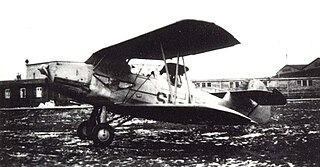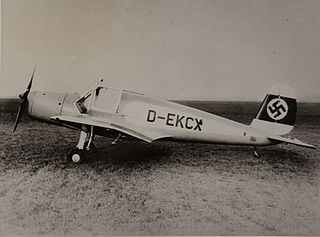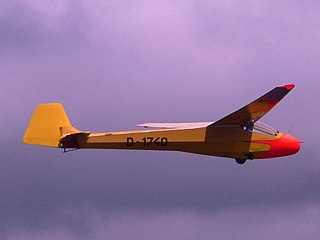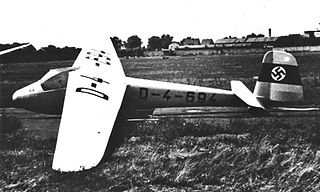
Alexander Lippisch's Delta IV was a continuation of his work on delta wing designs pioneered in his Delta I, Delta II and Delta III aircraft.

The Arado Ar 66 was a single-engined twin-seat training biplane designed and produced by the German aircraft manufacturer Arado. It was the last aircraft to be designed by the aeronautical engineer Walter Rethel in collaboration with Arado.

The Argus As 10 was a German-designed and built, air-cooled 90° cylinder bank-angle inverted V8 "low power" aircraft engine, used mainly in training aircraft such as the Arado Ar 66 and Focke-Wulf Fw 56 Stösser and other small short-range reconnaissance and communications aircraft like the Fieseler Fi 156 Storch during, and shortly after World War II. It was first built in 1928.

Entering service in 1915, the Rumpler C.I,, two-seater single-engine reconnaissance biplane, was one of the first German C-type aircraft, and also one of the longest serving in its class during World War I, being retired from the last front line units only in early 1918.

The Arado Ar 79 was an aerobatic two-seat trainer and touring aircraft designed and produced by the German aircraft manufacturer Arado. It was the final civilian aircraft developed by the company.
The Akaflieg Stuttgart F-1 Fledermaus (Bat) was a glider designed and built in Germany from 1932.
The Akaflieg Stuttgart fs16, nicknamed Wippsterz was a glider aircraft that was designed and built in Germany from 1936. Only one example of the design was constructed.
The Akaflieg Stuttgart fs17 was a glider aircraft that was designed and built in Germany from 1936. It notably featured a prone seating position for its pilot.
The Akaflieg Stuttgart fs18a was a glider designed and built in Germany from 1938. It was characterized by a gull wing and was the first glider to have a retractable undercarriage. Only one example of the design was constructed.

The Ago Ao 192 Kurier was a small German twin-engined aircraft designed and built by AGO Flugzeugwerke in the 1930s. A small production run of six aircraft followed three prototypes, these being used as transports.

The Akaflieg München Mü17 Merle is a single-place glider aircraft that was designed and built in Germany from 1938.

The Arado Ar 77 was a German twin-engined monoplane, designed as an advanced training aircraft from 1934.
The DFS Seeadler was a German flying boat sailplane designed by Hans Jacobs of the Deutsche Forschungsanstalt für Segelflug (DFS). It was version of the 1935 DFS Rhönadler, with a new fuselage and strongly gulled wings to keep them clear from spray. The aircraft was first flown in the summer of 1935, test piloted by Hanna Reitsch, and towed by a Dornier Do 12.

The Fieseler Fi 99 Jungtiger was a German sports aircraft prototype, produced by Fieseler company. The aircraft was a low-wing two-seat aircraft with an enclosed cabin. It was powered by a Hirth HM 506A engine, producing 160 hp (119 kW).

The Zündapp 9–092 or Z 92 was a German four-cylinder, air-cooled, inline aero engine made by Zündapp and used in light aircraft of the late-1930s.
The Schneider Grunau 8 was a simple, two-seat trainer glider designed and built in Germany in the early 1930s.

The Schmeidler SN.2 was a low power, single seat aircraft designed in Germany in the 1930s to test the ability of trailing edge wing extensions to lower minimum flight speeds without a high speed drag penalty.
The Gotha Go 241 was a low-wing twin-engined four-seat transport aircraft manufactured by Gothaer Waggonfabrik in the early 1940s and intended for the general aviation market.

The Akaflieg Berlin B5 was a glider built in Germany in the late 1930s. It featured a high-wing, cantilever sailplane configuration of all-wood construction, with cantilevered gull-wings, retractable landing-gear, all-moving-tail, dive air-brakes.

The Akaflieg Berlin B8 was a German sailplane built in the late 1930s for the 1939 Olympic games glider competition in Rome. It was a high-wing sailplane with a cantilever shoulder-wing, dive air-brakes and all wood construction.













